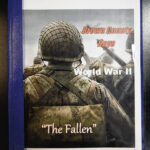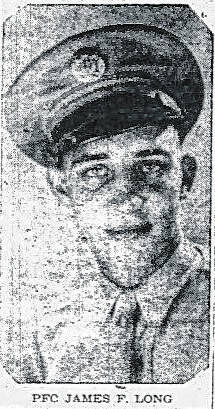Next to the D-Day invasion of Normandy and the subsequent Battle of Normandy, the battle that saw the second greatest number of American fatalities in World War II was the Battle of the Bulge, Dec. 16, 1944 through Jan. 25, 1945.
Among the fallen were Brown County boys Marvin “Jeep” Tutterow (19) of Helmsburg, killed two days before Christmas, James Gregory (24) of Jackson Township and Harry Kent (20) of Belmont.
James and Harry would die on the battlefield two days apart in January. James Long, also of Helmsburg, joined the battle the first week of January. James’ combat experiences were just beginning.
James Long had entered service on April 21, 1943. His enlistment was made note of in two separate columns of the April 22 edition of the Brown County Democrat.
One column listed him among the sixteen most recent Brown County boys to join the service. The list also included Harry Kent. A second column reported the family dinner held in honor of James on Sunday and those who attended. James would depart for basic training the following Wednesday.
After his basic training James would undergo Army Specialized Training in Maine. He then joined the 17th Airborne Division and began months of rigorous paratrooper training in North Carolina and later Tennessee.
The 17th Airborne did not depart for England until August of 1944, arriving in Liverpool Aug. 26 after the eight-day voyage across the Atlantic.
In England there was further intensive airborne training and in the backs of the minds of many of soldiers there was that lurking hope that the Germans would soon be overwhelmed and the war in Europe would be over before the end of the year.
All that changed on Dec. 16.
The Battle of the Bulge was Hitler’s last desperate offensive on the western front to change the course of the war. The plan was a lightning-fast attack to break through the Allied line in Belgium and take the port of Antwerp.
The Belgian port city was the terminus for the majority of the ships that brought the Allied forces everything they needed to defeat the Axis.
The Allies were caught by surprise. In fact, Allied Supreme Commander Eisenhower had made a bet with Field Marshal Montgomery in the fall that the war in Europe would be over before Christmas. He lost the bet.
The unprepared Allies were pushed back. The mountainous Ardennes Forest covered with fog, heavy snow and sub-freezing temperatures all worked to the advantage of the Germans. Normal superior Allied air support was non-existent due to the weather.
Reinforcements were soon needed. Units of the 17th Airborne were rushed into action. In a series of spectacular night landings, they were transported into France and then motored into Belgium.
The 17th was among the American divisions that ran head on into the numerically superior German forces. No other American division suffered as brutal and as high a casualty rate in their baptism of fire.
Fighting by day and dug into foxholes at night, frostbite was endemic. In his book, “Citizen Soldiers,” Stephen Ambrose relates, “Two themes dominate the memories of the men who fought the January battles: the cold and American artillery. Every veteran I have interviewed, from whatever side, agrees that this was the coldest they had ever been. Nights ranged from zero degrees to minus ten and lower. Men without shelter — other than a foxhole — or heat either stayed awake, stomping their feet, through the fourteen-hour night, or they froze.”
James was such a victim, suffering severely frostbitten feet. He was evacuated to Luxembourg and hospitalized for three weeks.
With the Germans stopped and retreating, James was now sent to a rest camp in France for another three weeks. He rejoined his unit where the 17th was in preparation for what would become the last full scale airborne drop of World War II.
Code named Operation Varsity, scheduled for March 24, the 17th would be dropped behind enemy lines across the Rhine River. Into Germany!
The only operation comparable to Operation Varsity was D-Day, June 6. Like Normandy, the prelude of bombing by B-17s and B-24s and artillery shelling was comparable.
However, with the airborne attack that followed there was no comparison. From horizon to horizon 1,696 transport planes filled with 21,680 paratroopers and glidermen filled the sky.
America General James Gavin described it aptly, “An awesome spectacle!”
James and his fellow troopers had experienced combat but this would be their first airborne jump into the fighting. They waited aboard their plane for the green light to flash. The commander jerked open the door. Air swirled in. Step forward. Step forward. Out the door!
The propellor blast hits and you are swept under the plane’s tail. A short free fall and then the usual agonizing shock as the chute opens. To those on the ground it was like thousands of mushrooms plummeting from the sky. For the troopers it was time to fight and hopefully survive.
Operation Varsity was an impressive logistical achievement. Through the end of March and early April the Allies kept pushing the Germans back taking control of the population centers in their path. The 17th relieved the 25th infantry Division and fought in the battle of the Ruhr Pocket.
On April 6 the objective was the Rhine-Herne Canal. It was here that a sniper’s bullet brought James down. He was 20.
Germany surrendered on May 7.
James was initially buried in Holland. He was brought home in November of 1948 with services at St. Agnes Chapel, Nashville prior to being interred in Morgantown.
James was survived by his parents Lillard and Mary (Robertson) Long, brothers Lillard Jr. and William C. and a sister Mary Ann.
Jim Watkins is a Brown County Historical Society member who wrote “The Fallen,” a memorial document about young men from Brown County who never returned home from World War II.

Watkins was a public school teacher for 42 years and has always been interested in learning about WWII. He can be reached at [email protected].






